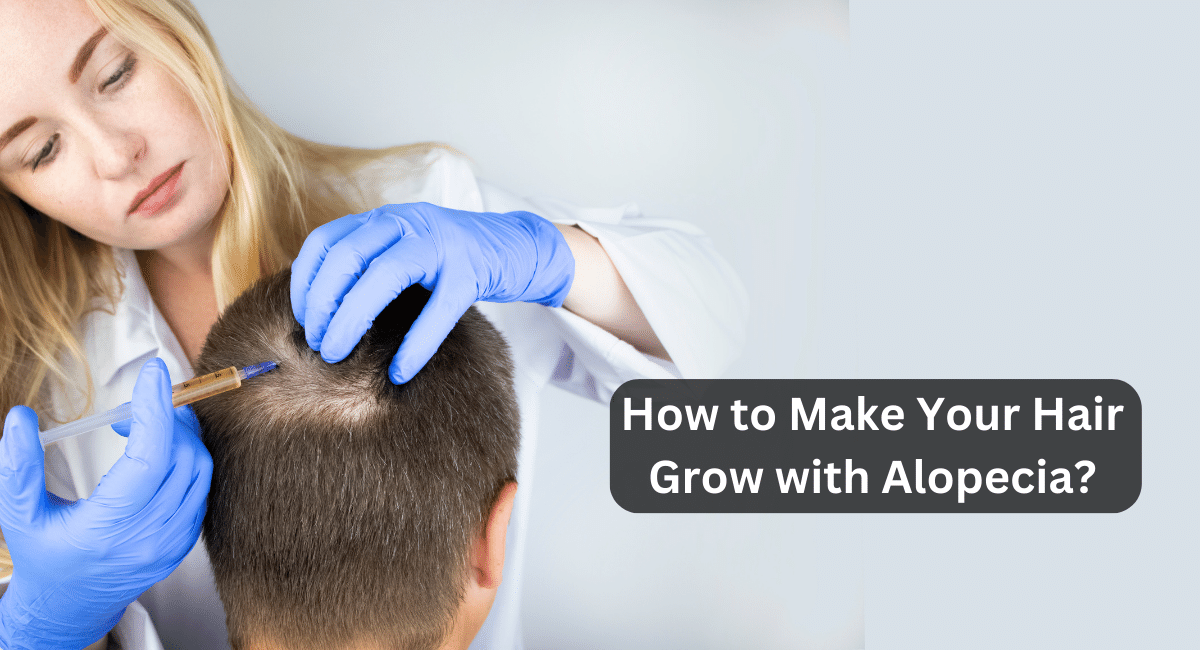Living with alopecia can be challenging, especially when it comes to maintaining healthy hair growth. Millions of people worldwide suffer from alopecia, a condition that causes hair loss. Knowing how to promote hair growth becomes essential if you have androgenetic alopecia, alopecia areata, or other types of hair loss. This thorough guide will examine doable tactics to encourage hair growth in the face of alopecia.
Types of Alopecia
1. Androgenetic Alopecia
This kind of hair loss usually starts off as a slow thinning of the scalp hair, which can eventually cause baldness in certain patterns, like a woman’s part line widening or a man’s hairline receding.
2. Alopecia Areata
A distinctive characteristic of alopecia areata is patchy hair loss, a condition believed to stem from the immune system mistakenly targeting hair follicles in an autoimmune response.
3. Traction Alopecia
Traction alopecia occurs due to excessive pulling or tension on the hair follicles, commonly seen in individuals who frequently wear tight hairstyles.
4. Telogen Effluvium
Telogen effluvium results in temporary hair shedding, often triggered by significant stress, hormonal changes, or nutritional deficiencies.
Causes of Alopecia
Numerous factors, such as hormonal imbalances, stress, genetic predisposition, and inadequate nutrition, can contribute to alopecia. Understanding these underlying causes is essential for effective management.
Understanding the Hair Growth Cycle
It’s crucial to grasp the hair growth cycle, consisting of the anagen, catagen, and telogen phases, to comprehend how to stimulate hair growth. Each stage plays a vital role in the growth and shedding of hair.
Natural Remedies for Hair Growth with Alopecia
1. Healthy Diet and Nutrition
Hair health is promoted from the inside out by eating a balanced diet full of vital nutrients like vitamins, minerals, and proteins. Hair follicles are nourished and growth is supported by eating fruits, vegetables, lean proteins, and omega-3 fatty acids.
2. Scalp Massage and Stimulation
Frequent scalp massages enhance blood flow to the hair follicles, supplying the nutrition and oxygen necessary for healthy hair development. Hair follicle activity can be increased by methods like using a scalp massager or your fingertips to make small, circular motions.
3. Essential Oils
Certain essential oils have qualities that promote healthy scalps and hair growth, like peppermint, rosemary, and lavender. The best way to use these oils is to dilute them with a carrier oil and massage them into the scalp.
4. Herbal Supplements
Many believe that supplements containing herbal ingredients like horsetail extract, ginseng, and saw palmetto can help mitigate the effects of dihydrotestosterone (DHT), a hormone associated with hair loss. It is believed that adding these supplements to your daily regimen will encourage the growth of new hair.
Medical Treatments for Alopecia
1. Minoxidil (Rogaine)
Minoxidil is an FDA-approved topical medication used to treat both male and female pattern baldness. It works by increasing activity in hair follicles and extending the anagen phase of the hair growth cycle.
2. Finasteride (Propecia)
For men suffering from androgenetic alopecia, finasteride is an oral drug that effectively reduces hair loss and promotes hair growth by blocking the conversion of testosterone to DHT.
3. Corticosteroids Injections
Corticosteroid injections are often administered directly into the scalp to reduce inflammation and suppress the immune response in individuals with alopecia areata, promoting hair regrowth in affected areas.
4. Hair Transplant Surgery
When healthy hair follicles from donor areas are transplanted to balding or thinning areas, hair transplant surgery can permanently treat hair loss in eligible patients.
Lifestyle Changes for Managing Alopecia
1. Stress Management Techniques
Reducing stress levels through deep breathing exercises, yoga, meditation, or other relaxation techniques can minimize the chronic stress-related hair loss.
2. Regular Exercise
Frequent exercise enhances blood flow to all parts of the body, including the scalp, which supports healthy hair growth and general well-being.
3. Adequate Sleep
Getting sufficient restorative sleep is essential for maintaining hormonal balance and supporting the body’s natural hair growth processes.
4. Avoiding Harsh Hair Treatments
Limiting harsh chemicals, heat styling tools, and tight hairstyles prevents further damage to hair follicles and encourages healthy hair growth.
Maintaining Overall Hair Health
1. Proper Hair Care Routine
Following a gentle hair care routine involves:
- Using mild shampoos.
- Conditioning regularly.
- Avoid excessive brushing or towel-drying.
- Preserving the integrity of hair strands.
2. Avoiding Heat Styling Tools
Hair dryers, straighteners, and curling irons, among other styling appliances, release excessive heat that can damage hair shafts, increasing breakage and possibly even hair loss.
3. Using Gentle Hair Products
Choosing hair products free of sulfates, parabens, and other harsh chemicals minimizes scalp irritation and maintains a healthy environment for hair growth.
Seeking Professional Help
1. Consulting a Dermatologist
Seeking guidance from a dermatologist specialized in treating hair disorders ensures personalized treatment plans tailored to your specific type of alopecia and overall health.
2. Support Groups and Counseling
Participating in support groups or pursuing counseling can offer psychological support and useful guidance for managing the psychological effects of alopecia.
Managing alopecia and promoting hair growth requires a comprehensive approach that addresses underlying causes, incorporates natural remedies, and may involve medical interventions. By embracing a healthy lifestyle, getting expert advice, and staying informed about available treatment options, individuals with alopecia can take proactive steps toward regaining confidence and achieving optimal hair health.

